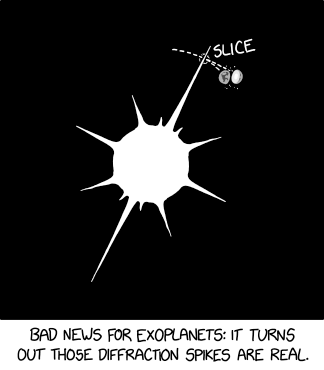Diffraction Spikes

Even if a planet is lucky enough to have a stable orbit that weaves between the spikes, the seasons get weird whenever it passes close to them.

Even if a planet is lucky enough to have a stable orbit that weaves between the spikes, the seasons get weird whenever it passes close to them.
Diffraction spikes are visual artifacts that appear to extend from light sources, mostly when viewed through a reflector telescope. In telescopes, they are often caused by the support struts of the secondary mirror in the telescope. They've become especially well known lately because they're quite prominent in images from the James Webb Space Telescope; its bigger spikes are due to the edges of the hexagonal mirror sections, not the struts.
The comic feigns that these artifacts are real spikes of stellar matter extending from the stars being viewed. The spikes have sufficient energy and coherence to slice planets that intersect them, rather than merely bludgeon or vaporize them. Additionally, they appear to nullify gravity, preventing the halves from recombining and allowing them to maintain their shape. This comic would later be referenced in 2765: Escape Speed as a "solid" star the player can land on.
The title text suggests that a planet would have to be particularly lucky to avoid encountering one of these spikes during its lifetime. This would make our own solar system exceptionally fortunate, given the number of planetary bodies that remain whole, though it could perhaps serve as an explanation for the Asteroid belt, being remnants of formerly destroyed planets. The title text also claims that the spikes produce sufficient light and heat to disrupt seasonal (and perhaps even diurnal) patterns on planets that come close enough to them, but this is not something we experience on Earth.